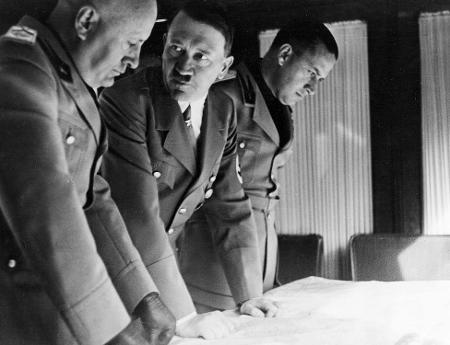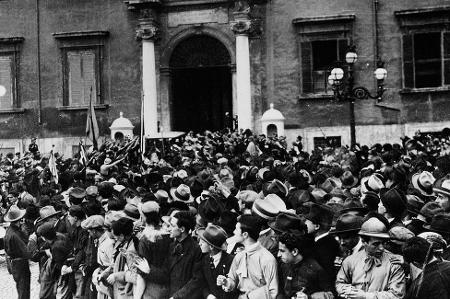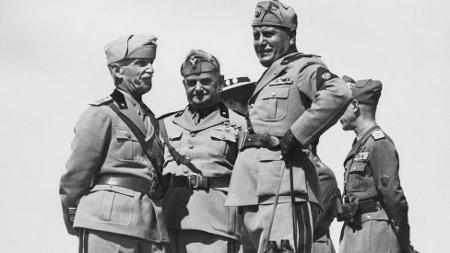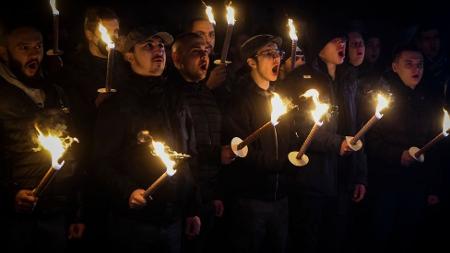The mobilization took place between 27 and 28 October 1922, when dozens of fascist militants began to take over towns and villages in northern and central Italy.
“Give us the government or we’ll go to Rome to get it.”
With these words, on October 24, 1922, Benito Mussolini told his many-armed supporters in the Plaza del Plebiscito in Naples that the capital of Italy was conquered by King III.
The National Fascist Party (PNF) was at that time an extreme force in Parliament, with only 35 out of a total of 535 MPs. The threat was serious, but few took it seriously.
- what is fascism?
And to the surprise of even his own followers, Mussolini, a journalist and former socialist revolutionary, achieved his goal and established the first fascist regime in history.
Its success would have serious consequences not only for the country but also for the rest of Europe and the world in the years that followed.
On the eve of completing the 100th anniversary of these events, the BBC’s Spanish service, BBC News Mundo, spoke with historians, analysts and political scientists to delve deeper into what happened.
Legend of the Revolution
The so-called March on Rome was an operation to seize power through an insurrection led by Mussolini.
The mobilization took place between October 27 and 28, 1922, when dozens of fascist militias, known as “black shirts” because of their uniforms, began to seize towns and villages in northern and central Italy, dismissing their legitimate authorities and occupying offices. soldier and police.
After vigorously taking control of cities such as Pisa, Florence, and Cremona in some cases, the “Blackshirts”, some armed with bayonets stolen from law enforcement, but most armed with shotguns, pistols, or clubs, headed for Rome.
In the capital, then-Prime Minister Luigi Facta ordered the army and police to stop Mussolini’s armies from entering “by any means”. And on October 28, he presented the king with a decree declaring a state of siege that would allow him to stop the rebels.
- ‘We hate and loathe dictatorship’: the historic speech announcing the Brazilian Constitution
However, the monarch did not sign the document. And in negative response Facta resigned.
A day later, Vítor Manuel 3° handed over the government to the leader of the rebels, who at first refused to share power with the more moderate ones because of the conditions imposed by the king. The king then withdrew from the terms and Mussolini, who was in Milan, went to Rome to accept the “offer”.
Even if the fascists achieved their goal, they invaded the Eternal City and on the 31st paraded in the Quirinal Palace, which was then the royal residence.
“One of the main myths of fascism was that it attacked power in October 1922. In fact, power was given to them on a platter,” explains historian Álvaro Lozano, the author of the book. Mussolini and Italian Fascism (“Mussolini and Italian Fascism”, in free translation).
lucky hit
Lozano says the march is far from the epic presented by his followers.
“After days of torrential rain in Rome, its members were not like Caesar’s legions, as Mussolini had imagined,” he says.
“Militarily, the march was a poorly planned operation,” explains the historian. “The 12,000 soldiers of the 16th Infantry Division of the 16th Army could have eliminated the fascists without much difficulty. The march was conducted in chaos and disorder. (…) It was a poker game that Mussolini excelled at.”
One factor supporting the rebels was the authorities’ lack of coordination. The security forces did not act against the insurgents, with few exceptions.
Taking advantage of the opponent’s mistakes
In 1919, Mussolini founded the Fasci Italiani di Combattimento group, an organization of World War I veterans.
The movement initially advocated republicanism, workers’ participation in industrial management, or the nationalization of religious organizations, but poor results at the polls led them to change their positions.
- How is neo-fascism advancing in Italy and how might it affect the rest of Europe?
They embraced nationalism and began to practice radical opposition to socialism, which helped them gain support among businessmen, the military, and the more conservative sections of Italian society.
According to Lozano, “Until mid-1922, Italy was on the verge of collapse as a result of the faltering economy”.
“In late July 1922, the socialist unions called for a general strike to force the government to take action against the fascists. Mussolini took the opportunity to show that the left poses a serious threat and that only fascism can fight it.” he adds. historian.
According to Lozano, “Fascists took control of public transport and kept postal services running.” “If the strikers protested, they were brutally attacked. (…) Mussolini managed to present himself as the guarantor of law and order.”
Venezuelan economist Humberto García Larralde, author of the book El Fascismo del Siglo 21: The Totalitarian Amenaza of the Political Project by Hugo Chavez (“Fascism in the 21st century: The totalitarian threat of Hugo Chavez’s political project,” in its free translation) adds another element to explain the height of the movement: the aftermath of World War I.
“Italy was on the side of the victors, but did not receive the additional territories expected from the allies, and this made large sections of society feel like they were part of the vanquished,” explains Larralde.
Fear, resignation, or both?
As if this were not enough, Mussolini also turned away from the democratic system in force in Italy after he took over the government.
In September 1922, Mussolini warned, “Fascism is the meeting of warriors, not politicians. (…) We are a war formation consolidated by fire, fire and destruction.” (leader or warlord).
But in this context, why didn’t the king declare a state of siege and appeal to the army to stop Mussolini?
There could be several reasons for Lozano. “Since the main politicians seemed to have accepted Mussolini’s entry into government, the king thought that the resistance made little sense,” he explains.
The historian recalls that in the Italian army there were many sympathizers of fascism who “cannot be trusted in a crisis situation.” And finally, he adds, “the king may have feared that his cousin, the Duke of Aosta (Emanuel Felisberto), who was a sympathizer of fascism, would be seen as a candidate for the throne.”
In the book of Italian historian Emilio Gentile in 1945, the ruler’s statement to the senators was “to prevent bloodshed”. And the Fu Subito Regime: Il Fascismo e la marcia su Roma (“And the regime was born: fascism and the march to Rome”, in free translation).
According to the historian, the king said “the authorities ensured that the armed fascists who came to Rome numbered 100,000.” The monarch’s decision would spell the end not only of Italy’s fragile democracy, but also of the monarchy he had intended to preserve.
‘A movement that insists on not dying’
Giorgia Meloni’s victory in the September 25, 2022 Italian general election brought fascism back into the war. Meloni is the leader of the Brothers of Italy party, which originated from the restructuring of the Italian National Right Social Movement (MSI), formed by former supporters of Mussolini.
But experts believe there is no cause for alarm.
“Meloni’s relationship with Mussolini is driven by nostalgia. (…) Despite the prevailing rhetoric about the return of the far right, there are no conditions for a return to fascist dictatorship,” Italian analyst Alberto Alemanno told BBC News Mundo. . Professor of community law at the HEC School of Economic Research in Paris, France.
According to the professor, “There are elements that indicate a rapid erosion of democratic infrastructure, similar to how Nazi fascism found fertile ground in Europe a century ago.”
“Today, with a technologically empowered civil society overseeing governments, there is much more checks and balances within and outside of government.”
Lozano warns that fascism is an ideology that “resists not dying” because it “has a strong appeal as an intermediate between communism and capitalism and attracts voters who have lost faith in traditional politicians.”
– This text was published at https://www.bbc.com/portuguese/internacional-63167615.
source: Noticias




